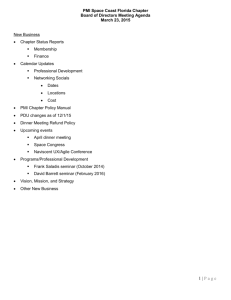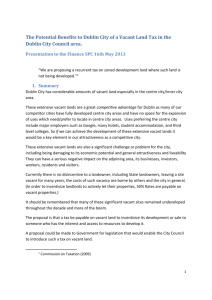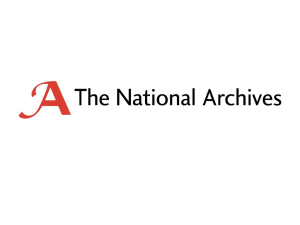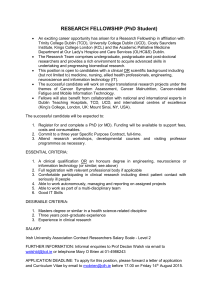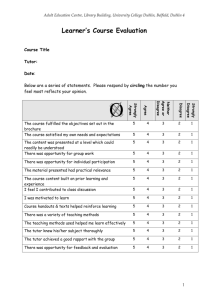Vacant Land Memorandum to Department of
advertisement
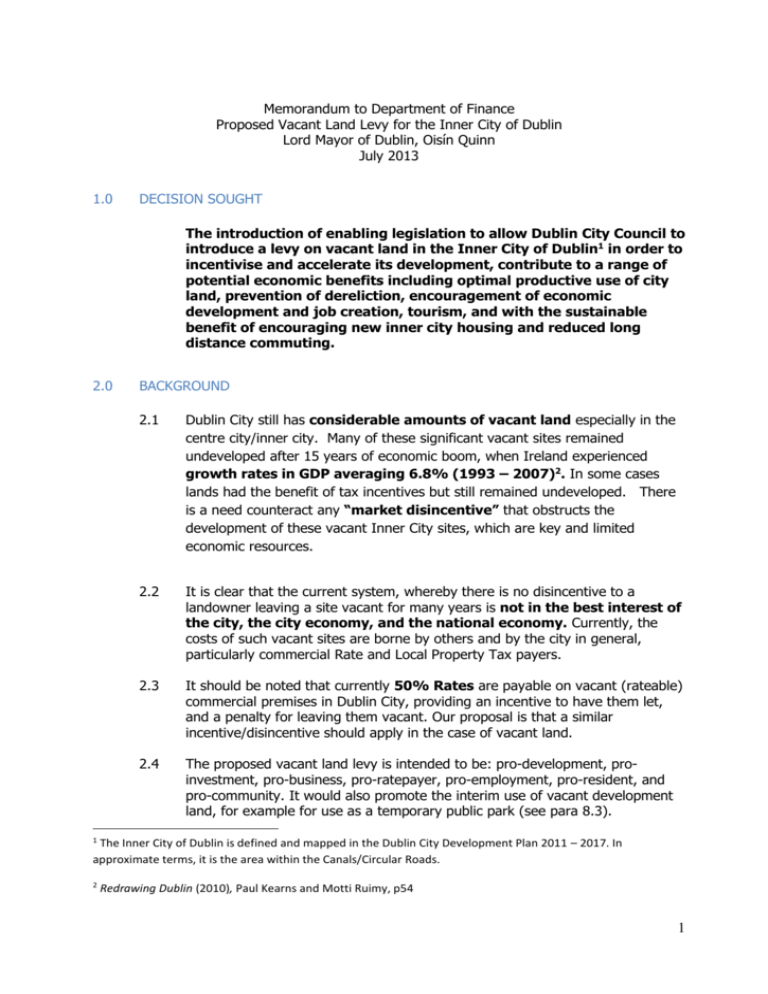
Memorandum to Department of Finance Proposed Vacant Land Levy for the Inner City of Dublin Lord Mayor of Dublin, Oisín Quinn July 2013 1.0 DECISION SOUGHT The introduction of enabling legislation to allow Dublin City Council to introduce a levy on vacant land in the Inner City of Dublin1 in order to incentivise and accelerate its development, contribute to a range of potential economic benefits including optimal productive use of city land, prevention of dereliction, encouragement of economic development and job creation, tourism, and with the sustainable benefit of encouraging new inner city housing and reduced long distance commuting. 2.0 BACKGROUND 2.1 Dublin City still has considerable amounts of vacant land especially in the centre city/inner city. Many of these significant vacant sites remained undeveloped after 15 years of economic boom, when Ireland experienced growth rates in GDP averaging 6.8% (1993 – 2007)2. In some cases lands had the benefit of tax incentives but still remained undeveloped. There is a need counteract any “market disincentive” that obstructs the development of these vacant Inner City sites, which are key and limited economic resources. 2.2 It is clear that the current system, whereby there is no disincentive to a landowner leaving a site vacant for many years is not in the best interest of the city, the city economy, and the national economy. Currently, the costs of such vacant sites are borne by others and by the city in general, particularly commercial Rate and Local Property Tax payers. 2.3 It should be noted that currently 50% Rates are payable on vacant (rateable) commercial premises in Dublin City, providing an incentive to have them let, and a penalty for leaving them vacant. Our proposal is that a similar incentive/disincentive should apply in the case of vacant land. 2.4 The proposed vacant land levy is intended to be: pro-development, proinvestment, pro-business, pro-ratepayer, pro-employment, pro-resident, and pro-community. It would also promote the interim use of vacant development land, for example for use as a temporary public park (see para 8.3). 1 The Inner City of Dublin is defined and mapped in the Dublin City Development Plan 2011 – 2017. In approximate terms, it is the area within the Canals/Circular Roads. 2 Redrawing Dublin (2010), Paul Kearns and Motti Ruimy, p54 1 2.5 3.0 The Lord Mayor of Dublin, Oisín Quinn, put in place a high level and representative Task Force to consider this submission to the Budget (see Appendix 1 for membership of the Task Force). DEFINITION 3.1 Currently there are the following types of land/property in the city in terms of their financial contribution to the city: A. Commercial building that is occupied and so paying 100% Rates B. Vacant commercial building paying 50% rates C. Vacant commercial buildings that are not capable of occupation and beneficial use in its current state pays no Rates or levies of any kind. (This incentivizes property owner's to render their buildings unusable by removing e.g. lifts etc). D. Vacant development land pays no Rates or levies of any kind. E. Housing pays Local Property Tax F. Sites that are on the Derelict Sites Register are obliged to pay 3% of market value (currently 38 on the Register in the City Council area). 3.2 Lands and buildings in categories C and D make no financial contribution to the City Council and the services that it provides. The fact that a building that is not capable of occupation and use pays no Rates is an incentive to the owners of commercial buildings to make them unusable by e.g. removing lifts, toilets etc so that no Rates are payable. 3.3 In terms of equity and fairness, one of the purposes of the proposed levy is that all property would make some financial contribution to the city. 3.4 For the purposes of the levy, the proposed definition of vacant land is as follows: Vacant land is zoned development land which has not been developed and does not have Rateable building/s on it. Only lands in the Inner City of Dublin as defined in the City Development Plan are subject to this vacant land levy. In approximate terms, the Inner City is that area within the Canals/Circular roads. 4.0 DEVELOPMENT PLAN CHALLENGES AND POLICIES 4.1 The proposed vacant land levy would be a significant step forward towards addressing key challenges and policies set out in the City Development Plan. It recognises that considerable progress has been made in improving Dublin over recent years and improved areas include the Docklands, Temple Bar and also Smithfield, Heuston etc. However, as the City Plan notes (p31) in its ‘Approach to the Inner City’; 2 There are the problems of ‘isolated clusters’, ‘a great sense of unevenness’, and a ‘significant number of vacant sites in the inner city that detract from its character and coherence’. 4.2 5.0 Accordingly the City Plan states; “It is a central aim of the core strategy to consolidate and enhance the inner city in order to augment its crucial role at the heart of the capital city and the city region. The inner city of Dublin is the most connected destination in the country and at international level, and supports a dynamic range of economic, educational and cultural clusters, together with a growing residential population.” (p22). DRIVING INNOVATION, PRODUCTIVITY AND COMPETITIVENESS “Cities offer three overlapping benefits for people and firms – proximity, density and variety”3. 5.1 There is general agreement amongst economists that the density and proximity in urban areas drives productivity and innovation. Accordingly extensive areas of, or large numbers of pockets of vacant urban land have a converse effect and are a significant drag on the city and national economic recovery4. 5.2 The Dublin City Council Development Plan Policy (RE14) sets out; “To recognise that cities are crucibles of innovation and that the city centre Z5 zoned area and inner city area including the Docklands is the crucial metropolitan and national resource for innovation, promoting the proximity and diversity of uses that foster innovation.” 5.3 Encouraging the development of extensive inner city lands provides a significant opportunity to boost the productivity and innovation potential of the city. If we can take steps to unlock the blockages to the development of these vacant central city lands, a key limited resource; it gives us a great competitive advantage to attract highly mobile international investment. NAMA and the IDA have already identified the lack of suitable office space in Dublin City as a potential competitive disadvantage that needs to be addressed. “FDI successes have strong knock on effects economically, and this includes in leisure, retail and most significantly property. As a result the number of properties in prime locations available for future FDI expansions is starting to reduce, creating a challenge in future years”, according to Barry O’Leary, CEO of the IDA in July 2013 3 Glenn Athey, Catherine Glossop, Ben Harrison, Max Nathan and Chris Webber (2007). Innovation and the City. NESTA. 4 For example see PRODUCTIVITY AND THE DENSITY OF HUMAN CAPITAL; Jaison R. Abel, Ishita Dey, Todd M. Gabe; Journal of Regional Science; Volumepages 562–586, October 2012 3 6.0 5.4 In their report, “Our Cities: Drivers of National Competitiveness” (2009), the National Competitiveness Council (NCC) stated regarding Dublin that, “we should not be complacent about its position as an internationally competitive location. Its continued success is critical for the performance of the entire economy. … The NCC supports the promotion of Dublin as a key driver of national competitiveness.” It refers to the need for “revitalizing previously dilapidated and abandoned areas in the centre of cities” and maximizing their potential. 5.5 These extensive areas of vacant lands are potentially a great international competitive advantage for Dublin. Many of our international competitor cities have fully developed centre city areas and have no space for the expansion of uses which need/prefer to locate in centre city areas. 5.6 Major employers in the ICT sector, the finance, legal and accountancy sectors, the hotel sector, student accommodation, and third level colleges typically prefer and seek city centre locations. Appropriate development of these extensive vacant lands in Dublin would add a key element to package our attractiveness as a competitive city. For example, Squarespace, recently announced that it is to establish its EMEA Headquarters in Dublin stating: "We are a Manhattan-based company with urban sensibilities. We want to be in a large, vibrant, cosmopolitan city. Dublin was the obvious choice from that perspective." 5.7 In this context, and for existing city users, these vacant lands are also a significant challenge and problem for the city. Vacant sites damage the economic potential and general attractiveness for and in the adjoining areas to the detriment of quality of life for residents, workers, businesses, investors, and visitors. Vacant sites are magnets for anti social behavior, vandalism, and illegal dumping, all of which place costs on the State and others. They are a disincentive to the maintenance and upkeep of an area in which businesses/ratepayers and residents have invested. By narrowing the Rates base, the hoarding of vacant city land increases the costs of doing business. Tax and Ratepayers subsidise those who hoard vacant land. 5.8 Few companies will base themselves in areas with a preponderance of vacant land – and its consequent impacts of, for example, fear of crime, potential for further deterioration - as they competing for employees and customers. A negative cycle of under-development is put in place. Companies may invest if they feel that the vacant land levy is a strong disincentive to hoarding of vacant land; and so a positive cycle is put in place. BENEFITS OF A VACANT LAND LEVY 6.1 As already stated, because there is no disincentive currently to a landowner for leaving a site vacant for many years, and the costs of such vacancy are borne by others and the city in general, it is proposed to introduce a levy to remedy this situation. It is considered that an appropriate levy, to be payable on vacant land, would incentivise and accelerate its development, or foster its sale to those who have the interest, and access to resources, to develop it. 4 7.0 6.2 Such a levy would have a range of potential economic benefits. As already stated, these include encouraging more optimal productive use of city land, preventing dereliction, encouraging economic development and job creation, and with sustainability benefits in encouraging new inner city housing and so far less long-distance commuting, reducing costs to business, encouraging tourism and restoring community pride in a neighborhood. 6.3 Encouraging the optimal use of land is particularly appropriate in city areas such as Dublin where there has been and will be considerable public investment in providing services such as public transport (e.g. Luas); and these vacant sites are not delivering the economic return to the public and the city for such considerable public investment. 6.4 A requirement could be put in place for the City Council to keep a public vacant land register of the site location, a site map, its area, ownership etc. and also make it available on-line. It would be very useful market information for investors and developers, as well policy makers, concerned members of the public and others. There is already a requirement on local authorities to keep a Derelict Sites Register5. 6.5 A vacant land levy should be seen as part of a suite of revitalisation measures being taken by the City Counci, Government, the private, community and philanthropic sectors to continue to enhance the attractiveness and competitiveness of the city. Other initiatives include the 60 million euro Parnell Square Cultural Quarter; the 370 million euro BXD Luas line; the Jessica EU funding project; the 26% reduction in City Council development levies; IDA plans for a 21st century IFSC6; the multi-million Dubline Failte Ireland/City Council visitor route College Green to Kilmainham. Temporary uses such as allotments and event spaces are being introduced on City Council owned sites, one example being the ‘GRANBY PARK’ on Dominick Street SUPPORTING POLICY AND RESEARCH 7.1 The Commission on Taxation (2009) considered these issues in detail and concluded: We are proposing a recurrent tax on zoned development land where such land is not being developed. This will be a useful policy tool to address the hoarding of land-banks and help to ensure that land is utilised in accordance with its planning categorisation. 7.2 The Tax Strategy Group report (2010) also set out the benefits of a land value tax as including; - 5 It encourages compact city centre development http://www.irishstatutebook.ie/1990/en/act/pub/0014/sec0008.html#sec8 6 http://www.independent.ie/business/irish/ida-aims-to-create-new-ifscdistrict-29347911.html 5 - and the most productive use of high value land ……. Those who have not developed valuable land are encouraged to do so It counteracts any market disincentive to develop the land. 7.3 The All Party Oireachtas Committee on the Constitution (APOCC, 2004) in its 9th Progress Report on Private Property7 recommended the following: “The government should devise a scheme comprising a structure of progressive charges, whereby planning authorities can secure the release of development lands where development is not being actively pursued by the owners or the development land is not being placed on the market by them.” (Page 86) 7.4 In a paper on “Approaches to Land Management, Value and Betterment” (2004), The National Economic and Social Council (NESC) states that the APOCC analysis of the land market is that this market operates imperfectly. The system of land use planning leads to ‘a perceived shortage of development land’, a signal to entrepreneurs to involve themselves in the acquisition and holding of zoned development land and ‘an incentive to maintain the shortage and keep values up by not developing the land until it suits their interest’ (APOCC, 2004: 84-5). This implies that there may be artificial scarcities of land and land prices that may be higher than necessary.” 7.5 Although we are not proposing a site value tax as such, the benefits set out for such a site value tax also apply to a vacant land levy. So for example, the NESC paper continues, “A site value tax could possibly improve land use by encouraging infill development; i.e. the development of unused or underutilised land in existing urban areas. It also acts as a penalty on derelict sites since the owners are liable for the site value tax even if the site is not generating an income. If withholding of land were to occur, a site value tax could provide an incentive to avoid this. Taken together these potentially provide an incentive for improved land use and hence would potentially support better planning.” 7.6 A site value tax can be expected to put downward pressure on land prices, since a buyer of land (or property) is acquiring an ongoing liability to pay the land tax as well as the asset, according to the NESC. Annual property taxes are common across OECD countries. They are typically applied to both the value of land and buildings. In Denmark there is a specific tax on land or site values. In 7 http://archive.constitution.ie/reports/9th-Report-Property.pdf 6 a submission to the Barker Review of housing policy in the UK, it was argued by Muellbauer (2003), a leading British economist, that the Danish land tax improves the functioning of the land use planning system, by increasing the costs of land hoarding when land prices are high, so increasing land supply counter-cyclically. 7.7 8.0 In a May 2013 Article IV report to the UK Government, the IMF stated that “To mitigate this risk [of house price increases] and engineer a supply response, the government should consider fiscal disincentives for holding land without development.” 8 HOW A VACANT SITE LEVY SCHEME COULD WORK 8.1 The amount of the levy would be a matter to be considered. Under the Derelict Sites Act, such sites are obliged to pay a levy of 3% of market value can be charged (see Appendix 2). 8.2 The primary purpose of the vacant land levy is that the land be developed or used so that it is no longer blight on the city. The legislation could provide for a reduced/zero levy where the site has a compliant interim use such as a temporary park or playground9. A temporary surface car park would be excluded as this is an unsustainable use with an income that dis-incentivises its proper development. 8.3 The Local Government Business Improvement Districts Act 2006 is a precedent in that it allowed the City Council by resolution to specify a part of its administrative area as a Business Improvement District and introduce inter alia a levy (see Appendix 3). 9.0 CONCLUSION 9.1 8 To deliver on the Dublin City Development Plan and national objectives for the city, to enhance Dublin’s attractiveness as an economic, business and tourist location, to achieve for the residents, workers, businesses and visitors an integrated and attractive city and to tackle the no-cost lock on vacant land currently enjoyed by landowners that is advantageous only to them, it is recommended that legislation that would allow Dublin City Council to introduce a levy on such vacant land in the Inner City be approved. http://www.imf.org/external/np/ms/2013/052213.htm 9 For a US example see; http://www.brooklyndaily.com/stories/2013/31/all_vacantlandincentives_2013_08_02_bk.html 7 9.2 Consideration could be given to examining and reporting on its effectiveness over a period, and as a possible model for other urban locations in the country generally. APPENDICES Appendix 1: Lord Mayors Task Force on Vacant Land Levy, membership included: Chairperson: Oisín Quinn, Lord Mayor of Dublin Danny McCoy, CEO, IBEC David Begg, General Secretary, ICTU Tom Dunne Head of School of Real Estate and Construction Economics, DIT Killian O'Higgins, Chartered Surveyor Derek Tynan, DTA Architects Brendan Williams lecturer in Urban Development and Urban Economics, UCD David Brennan, CEO Dublin City Business Association. Micheál Collins, Senior Research Officer, Nevin Economic Research Institute Cllr Mary Freehill Cllr Ruairi McGinley Philip Maguire, Acting Dublin City Manager Kathy Quinn, Head of Finance, Dublin City Council (DCC) Peter Finnegan, Director, Office of Economy and International Relations, DCC Jim Keogan, Assistant City Manager, Planning and Economic Development, DCC Ali Grehan, Dublin City Architect Kieran Rose, Senior Planner, DCC Paul Kearns, Senior Executive Planner, DCC Appendix 2: Derelict Sites Act 1990 The Derelict Sites Act 1990 allows a local authority to take action in relation to a site that is ‘derelict’ within the term of the Act. Landowners, who do not comply with a notice to carry out certain specified improvement works, can be levied 3% of the market value of the land. However not all vacant land would come within the legal definition of ‘derelict’, hence there is a gap in the legal infrastructure. Section 3 of the Act sets out the following: 3.—In this section “derelict site” means any land (in this section referred to as “the land in question”) which detracts, or is likely to detract, to a material degree from the amenity, character or appearance of land in the neighbourhood of the land in question 8 because of— (a) the existence on the land in question of structures which are in a ruinous, derelict or dangerous condition, or (b) the neglected, unsightly or objectionable condition of the land or any structures on the land in question, or (c) the presence, deposit or collection on the land in question of any litter, rubbish, debris or waste, except where the presence, deposit or collection of such litter, rubbish, debris or waste results from the exercise of a right conferred by statute or by common law. Appendix 3: Local Government Business Improvement Districts Act 2006 129B.— (1) Subject to and in accordance with this Part, the rating authority for an administrative area may by resolution— (a) specify an area within the administrative area and establish that area as a business improvement district, and (b) approve implementation of a scheme (‘BID scheme’) to carry out or provide one or more projects, services or works described in subsection (2) and which scheme is financed in whole or in part by BID contribution levies under this Part. 9
